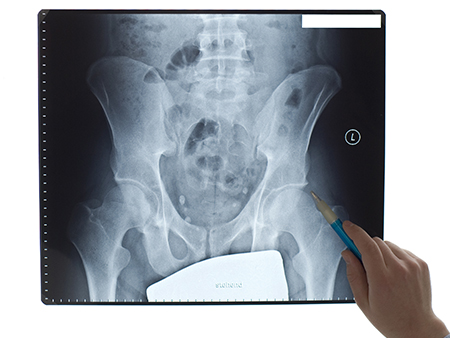Understanding the Prevalence of Femoroacetabular Impingement (FAI) Syndrome in the General Population
 Currently, there is no cure for hip osteoarthritis (OA). Arthritis Research Canada’s researchers have been studying the causes of hip pain in order to determine how to slow or prevent the progression of the disease. Femoroacetabular Impingement (FAI), a condition caused by a bone deformity in the hip joint and a source of hip pain in young adults, has been suggested as a major cause of hip OA.
Currently, there is no cure for hip osteoarthritis (OA). Arthritis Research Canada’s researchers have been studying the causes of hip pain in order to determine how to slow or prevent the progression of the disease. Femoroacetabular Impingement (FAI), a condition caused by a bone deformity in the hip joint and a source of hip pain in young adults, has been suggested as a major cause of hip OA.
If FAI leads to developing hip OA, researchers need to find out how many people actually have the condition. To answer this question, Dr. Jacek Kopec, Co-Investigator on the IMPAKT-HiP project and Senior Scientist at Arthritis Research Canada, led a large population-based study consisting of 500 Caucasian adults from ages 20 to 49 in Metro Vancouver. The study, recently published in the Journal of Rheumatology is the first sample of this scale to produce results relevant to the Caucasian population, finding. 3% of young and middle-aged Caucasian adults in Metro Vancouver have the condition.
Diagnosing FAI with Better Accuracy
Characterizing FAI isn’t always simple. There are various assessment methods and several ways to define it, with a large range in results it makes it difficult to diagnose and study. An international panel of experts established a standardized method to assess FAI, by combining three consistent components to define FAI syndrome: symptoms, clinical examinations, and x-ray.
Using this improved assessment, Dr. Kopec and his team are now closer to finding a more accurate number of people with FAI. This is the first research effort of its kind to examine a younger cohort (20 to 49 year olds) when people are said to be ‘in the prime of their life’ and when lifestyle adjustments can be made to prevent hip pain or OA. “We found that hip pain is more common in this group than previous studies have suggested,” says Dr. Kopec.
Findings May Help Health Professionals Improve Detection and Treatment for FAI
X-rays are often the only method used to diagnose FAI in population-based research. This study shows that in many cases the bone shape changes on x-ray may not be related to hip symptoms. “Our findings tell us that symptom history and physical hip examinations are significantly associated but the correlation between hip symptoms and x-ray findings is not very strong,” says Kopec.
According to Dr. Charles Ratzlaff, sports physical therapist, and a Co-Investigator on the IMPAKT-HiP project, other factors such as muscle strength and neuromuscular control also play a significant role in hip pain and function.
“Through early detection and proper assessment, we may be able to help develop recommendations to prevent hip OA, reducing costly surgeries and improving the quality of life for many Canadians,” Dr. Kopec emphasizes. “In terms of next steps, further research is needed to develop consistent criteria for assessing hip symptoms, physical signs, and the structure of the hip joint, while better understanding the relationships between them.”
To access publication, click here.
For additional information on the ground-breaking work done by the IMPAKT-HiP team at Arthritis Research Canada, please visit here.





















































